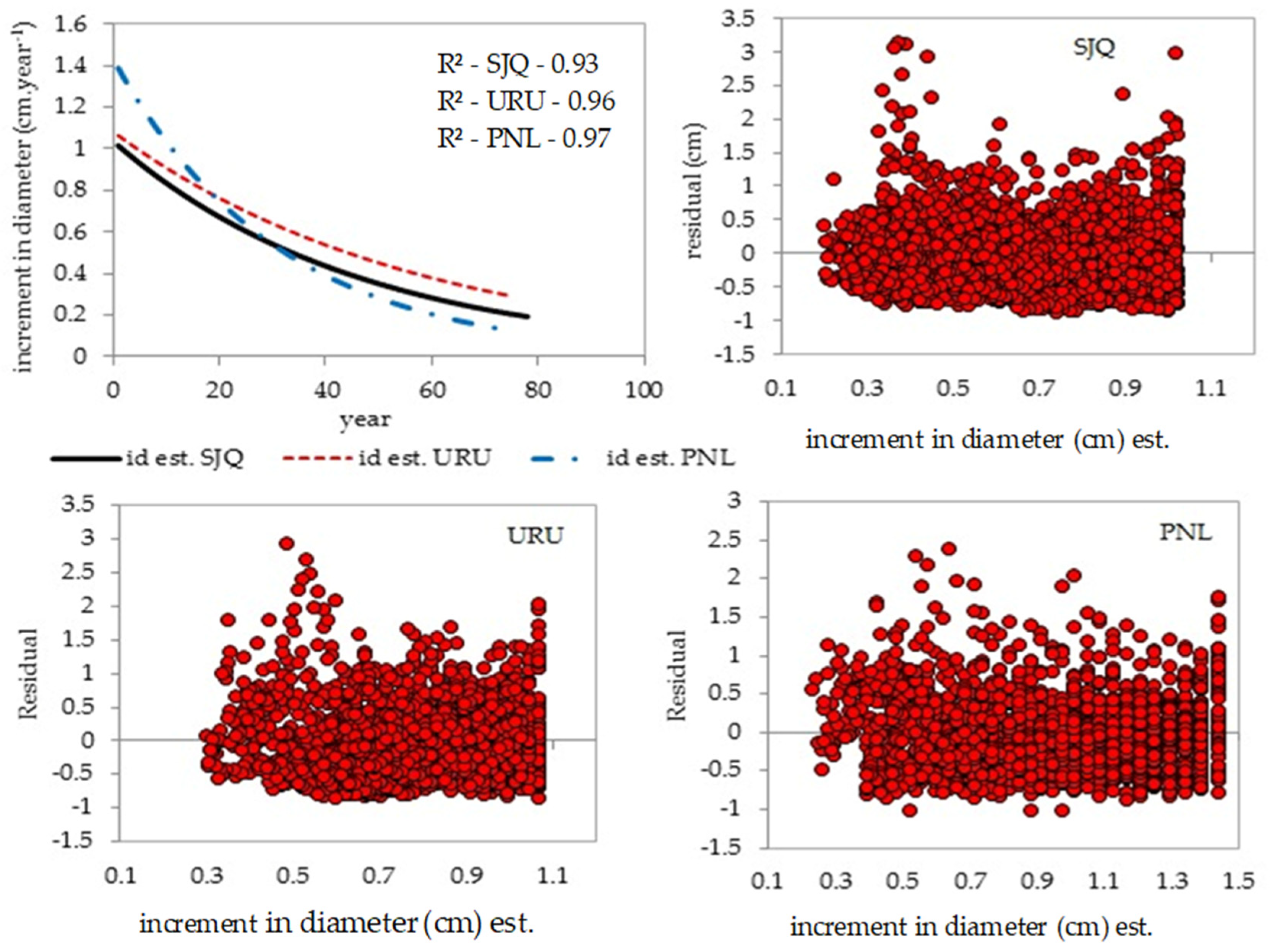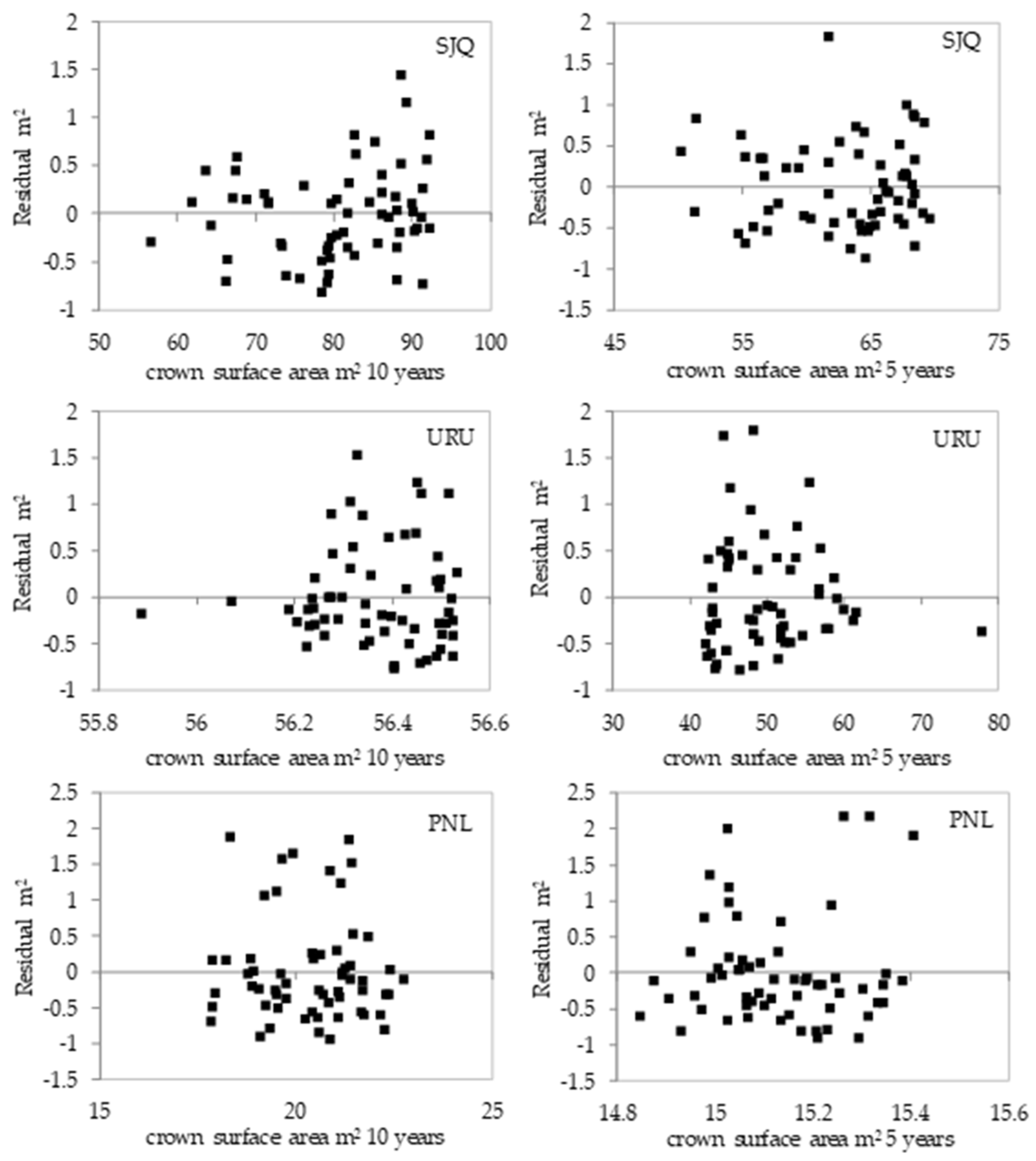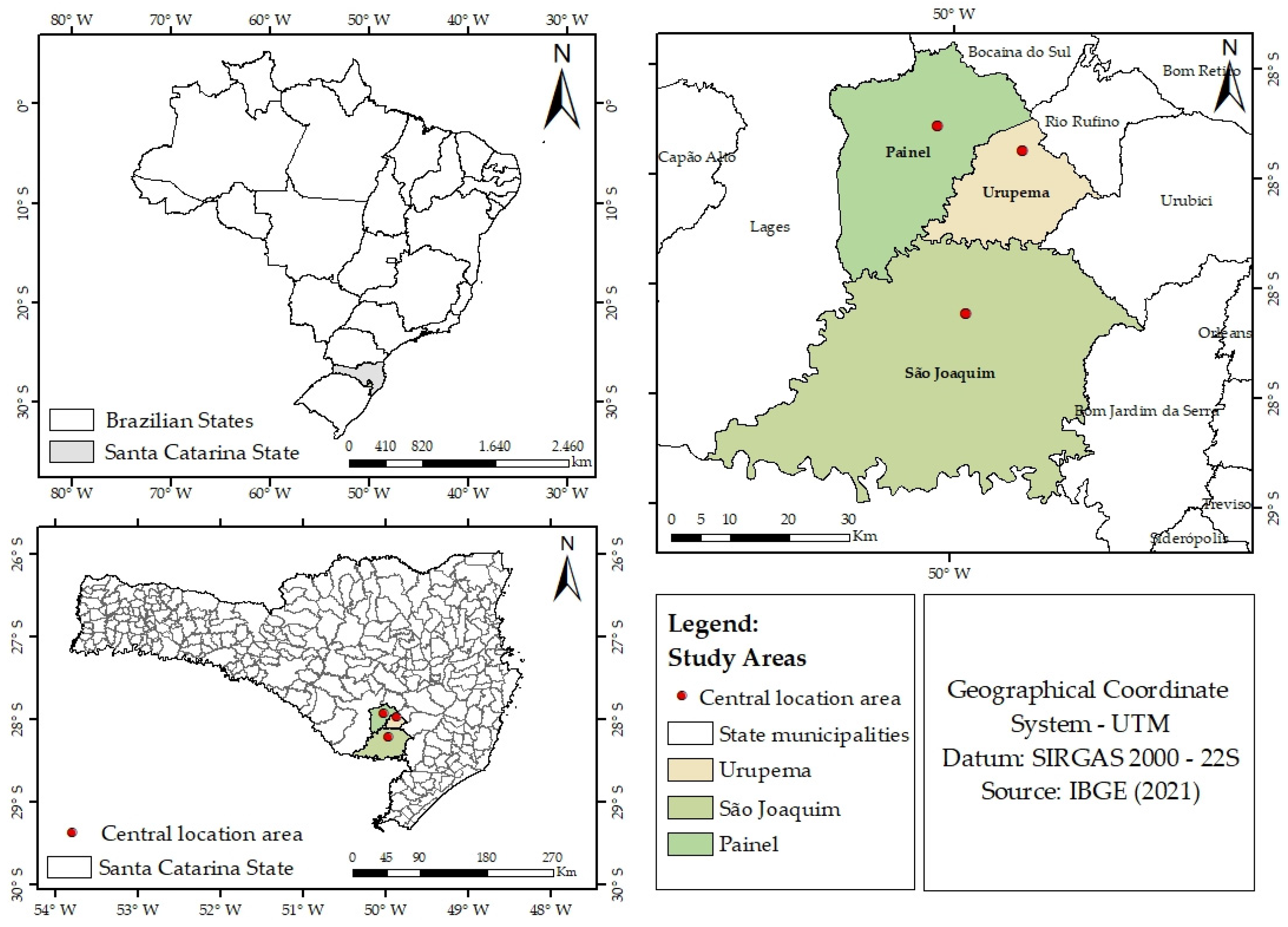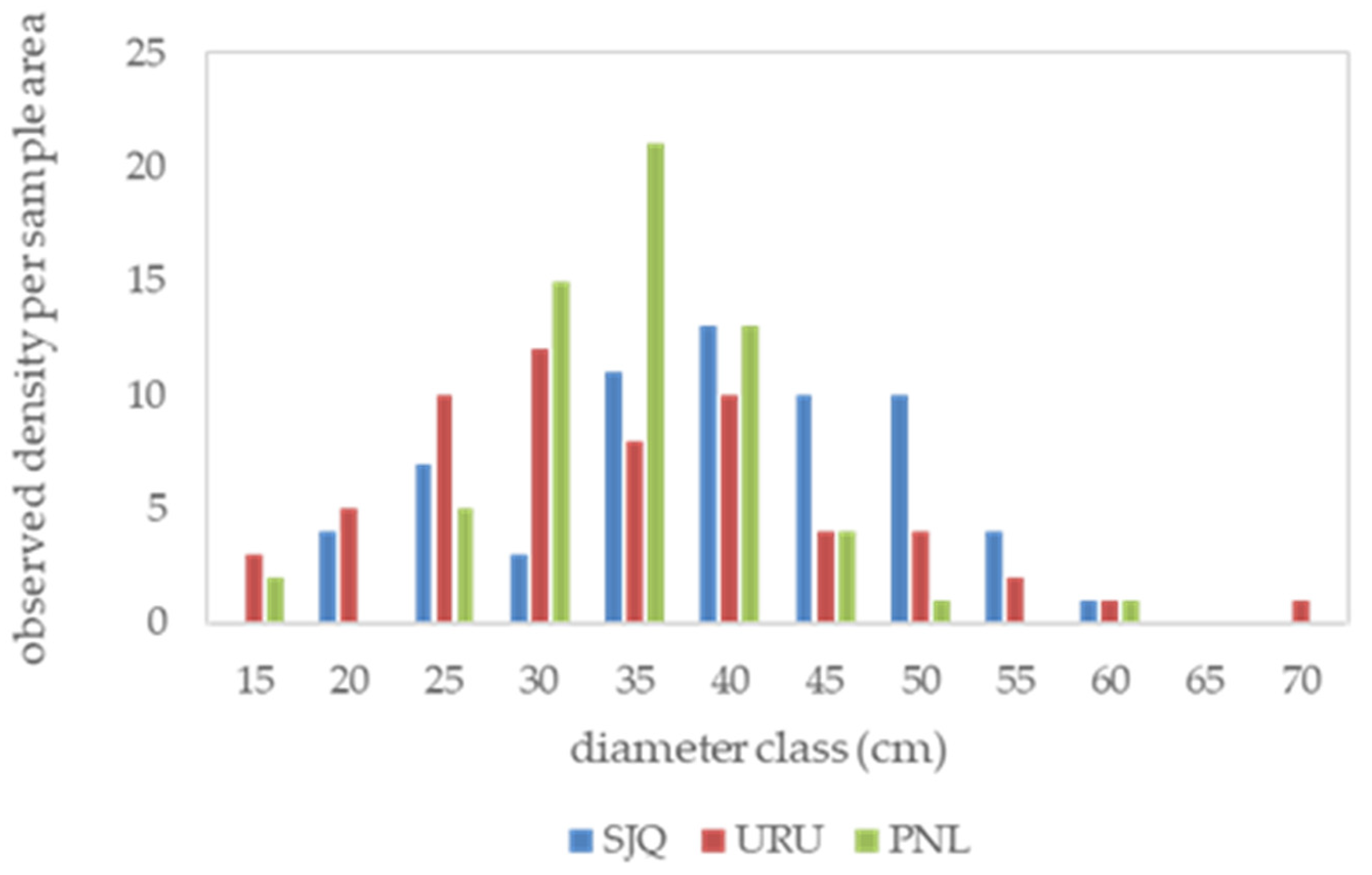Can Shape–Size–Increment Models Guide the Sustainable Management of Araucaria Forests? Insights from Selected Stands in Southern Brazil
Abstract
1. Introduction
2. Materials and Methods
2.1. Description of the Study Areas
2.2. Measurements and Statistical Analysis
3. Results
3.1. Analysis of Descriptive Statistics and Models Fitted
| SJQ | ||||
|---|---|---|---|---|
| Variable | Mean | Max | Min | Std |
| d | 41.3 | 60.2 | 20.1 | 9.8 |
| cd | 9.7 | 16.6 | 4.2 | 2.7 |
| si | 0.23 | 0.31 | 0.16 | 0.03 |
| cl | 5.1 | 10.9 | 1.6 | 1.8 |
| csa10 | 80.1 | 216.4 | 13.9 | 42.2 |
| csa5 | 63.5 | 174.3 | 8.5 | 33.8 |
| cf | 2.3 | 6.1 | 0.8 | 1.3 |
| ce | 0.0043 | 0.018 | 0.0007 | 0.0034 |
| id | 0.7 | 4.1 | 0.09 | 0.4 |
| APId10 | 0.4 | 0.8 | 0.2 | 0.15 |
| APId5 | 0.3 | 0.7 | 0.1 | 0.15 |
| URU | ||||
| d | 36.6 | 70.1 | 18.8 | 11.1 |
| cd | 8.2 | 13.5 | 4.1 | 2.2 |
| si | 0.23 | 0.31 | 0.1 | 0.04 |
| cl | 5.3 | 13.1 | 0.3 | 2.3 |
| csa10 | 56.4 | 142.1 | 13.2 | 30.3 |
| csa5 | 49.7 | 134.5 | 9.8 | 28.6 |
| cf | 2.5 | 38.7 | 0.8 | 4.7 |
| ce | 0.0032 | 0.0088 | 0.0008 | 0.0018 |
| id | 0.7 | 3.2 | 0.1 | 0.4 |
| APId10 | 0.24 | 0.65 | 0.1 | 0.1 |
| APId5 | 0.21 | 0.69 | 0.08 | 0.11 |
| PNL | ||||
| d | 37.5 | 62.7 | 23.6 | 6.7 |
| cd | 4.5 | 8.8 | 1.3 | 1.7 |
| si | 0.12 | 0.22 | 0.03 | 0.04 |
| cl | 6.3 | 12.0 | 1.0 | 2.3 |
| csa10 | 20.2 | 60.8 | 1.2 | 14.3 |
| csa5 | 10.5 | 29.6 | 1.3 | 11.3 |
| cf | 0.9 | 4.6 | 0.2 | 0.6 |
| ce | 0.013 | 0.0526 | 0.0026 | 0.0097 |
| id | 0.9 | 3.9 | 0.002 | 0.6 |
| APId10 | 0.53 | 0.88 | 0.25 | 0.18 |
| APId5 | 0.41 | 0.66 | 0.09 | 0.14 |
3.2. Assessment of the Structure, Dynamics, and Growth of the Forest Ecosystem





4. Discussion
5. Conclusions
Author Contributions
Funding
Data Availability Statement
Acknowledgments
Conflicts of Interest
Appendix A


References
- Randin, J.C. Um olhar sobre a colonização da fronteira sul. In História da Fronteira Sul; Radin, J.C., Valentini, D., Zarth, P., Eds.; Federal University of the Southern Border: Chapecó, Brazil, 2016; pp. 146–166. [Google Scholar]
- Salini, A.M. Colonização e meio Ambiente: A Transformação da Paisagem do Oeste Catarinense (1930 a 1970). Master’s Thesis, Federal University of the Southern Border, Chapecó, Brazil, 2018; 150p. [Google Scholar]
- De Sá, D.N.; Nodari, E.S.; Gerhardt, M. Colonização e transformação de paisagens na floresta com araucárias no século XX. Estud. Hist. 2023, 36, 518–541. [Google Scholar] [CrossRef]
- Ordinance n° 37 of the Brazilian Institute of Environment and Natural Resources. In Recognizes the Official List of Species of Brazilian Flora Threatened with Extinction; Brazilian Institute of Environment and Natural Resources: Brasília, Brazil, 1992.
- Conama Resolution n° 278. In Provides for the Cutting and Exploitation of Endangered Species of Flora; National Environment Council (CONAMA): Brasília, Brazil, 2001.
- Eisfeld, R.L. Research, Legislation, Planting and Management of Araucaria angustifolia (Bertol.) O. Kuntze: Perspectives and Solutions. Ph.D. Thesis, Federal University of Parana, Curitiba, Brazil, 2020; p. 261. [Google Scholar]
- Seidl, R.; Thom, D.; Kautz, M.; Martin-Benito, D.; Peltoniemi, M.; Vacchiano, G.; Wild, J.; Ascoli, D.; Petr, M.; Honkaniemi, J.; et al. Forest disturbances under climate change. Nat. Clim. Change 2017, 7, 395–402. [Google Scholar] [CrossRef]
- Rodrigo, R.M.; Pettit, J.L.; Janda, P.; Pavlin, J.; Ralhan, D.; Kozak, D.; Matula, R.; Marchand, W.; Bače, R.; Dušátko, M.; et al. Past disturbance shape present tree size distribution in European temperate primary beech-dominated forests. For. Ecol. Manag. 2024, 574, 122364. [Google Scholar] [CrossRef]
- Bowman, D.M.J.S.; Brienen, R.J.W.; Gloor, E.; Phillips, O.L.; Prior, L.D. Detecting trends in tree growth: Not so simple. Trends Plant Sci. 2013, 18, 11–17. [Google Scholar] [CrossRef]
- Stepka, T.F.; de Mattos, P.P.; Filho, A.F.; Machado, S.A.; Braz, E.M. How are diameter growth, forest structure and carrying related in tree populations? Eco. Model. 2025, 506, 111141. [Google Scholar] [CrossRef]
- Grebner, D.L.; Bettinger, P.; Siry, J.P. Introduction to Forestry and Natural Resources; Academic Press: New York, NY, USA, 2013; p. 508. [Google Scholar]
- Bergseng, E.; Ask, J.A.; Framstad, E.; Gobakken, T.; Solberg, B.; Hoen, H.F. Biodiversity protection and economics in long term boreal forest management—A detailed case for the valuation of protection measures. For. Pol. Econ. 2012, 15, 12–21. [Google Scholar] [CrossRef]
- Eyvindson, K.; Repo, A.; Mönkkönen, M. Mitigating Forest biodiversity and ecosystem service losses in the era of bio-based economy. For. Pol. Econ. 2018, 92, 119–127. [Google Scholar] [CrossRef]
- Albrich, K.; Rammer, W.; Thom, D.; Seidl, R. Trade-offs between temporal stability and level of forest ecosystem services provisioning under climate change. Ecol. Appl. 2018, 28, 1884–1896. [Google Scholar] [CrossRef]
- Seidl, R.; Schelhaas, M.J.; Rammer, W.; Verkerk, P.J. Increasing forest disturbances in Europe and their impact on carbon storage. Nat. Clim. Change 2014, 4, 806–810. [Google Scholar] [CrossRef]
- Seidl, R.; Klonner, G.; Rammer, W.; Essl, F.; Moreno, A.; Neumann, M.; Dullinger, S. Invasive alien pests threaten the carbon stored in Europe’s forests. Nat. Commun. 2018, 9, 1626–1710. [Google Scholar] [CrossRef]
- Mauri, A.; Girardello, M.; Forzieri, G.; Manca, F.; Beck, P.S.A.; Cescatti, A.; Strona, G. Assisted tree migration can reduce but not avert the decline of forest ecosystem services in Europe. Glob. Environ. Change 2023, 80, 102676. [Google Scholar] [CrossRef]
- Santopuoli, G.; Temperli, C.; Alberdi, I.; Barbeito, I.; Bosela, M.; Bottero, A.; Klopčič, M.; Lesinski, J.; Panzacchi, P.; Tognetti, R.; et al. Pan-European sustainable forest management indicators for assessing Cli-mate-Smart Forestry in Europe. Can. J. For. Res. 2021, 51, 1741–1750. [Google Scholar] [CrossRef]
- Binkley, D. A hypothesis about the interaction of tree dominance and stand production through stand development. For. Ecol. Manag. 2004, 190, 265–271. [Google Scholar] [CrossRef]
- Binkley, D.; Stape, J.L.; Ryan, M.G.; Barnard, H.R.; Fownes, J. Age-related decline in forest ecosystem growth: An individual-tree, stand-structure hypothesis. Ecosystems 2002, 5, 58–67. [Google Scholar] [CrossRef]
- Weiskittel, A.R.; Maguire, D.A.; Monserud, R.A. Modeling crown structural responses to competing vegetation control, thinning, fertilization, and Swiss needle cast in coastal Douglas-fir of the Pacific Northwest, USA. For. Ecol. Manag. 2007, 245, 96–109. [Google Scholar] [CrossRef]
- Wang, B.; Bu, Y.; Tao, G.; Yan, C.; Zhou, X.; Li, W.; Zhao, P.; Yang, Y.; Gou, R. Quantifying the effect of crown vertical position on individual tree competition: Total overlap index and its application in sustainable forest management. Sustainability 2020, 12, 7498. [Google Scholar] [CrossRef]
- Finger, C.A.G.; Costa, E.A.; Hess, A.F.; Liesenberg, V.; Bispo, P.C. Simulating sustainable forest management practices using crown attributes: Insights for Araucaria angustifolia trees in southern Brazil. Forests 2023, 14, 1285. [Google Scholar] [CrossRef]
- Ford, E.D.; Sorrensen, K.A. Theory and models of inter-plant competition as a spatial process. In Individual-Based Models and Approaches in Ecology: Populations, Communities, and Ecosystems; Taylor & Francis: Abingdon, UK, 1992; pp. 363–407. [Google Scholar]
- Fujimori, T. Ecological and Silvicultural Strategies for Sustainable Forest Management; Elsevier: Amsterdam, The Netherlands, 2001. [Google Scholar]
- Weiskittel, A.R.; Hann, D.W.; Kershaw, J.A., Jr.; Vanclay, J.K. Forest Growth and Yield Modeling; John Wiley & Sons: Hoboken, NJ, USA, 2011. [Google Scholar]
- Zhang, J.; Huang, S.; He, F. Half-century evidence from western Canada shows forest dynamics are primarily driven by competition followed by climate. Proc. Natl. Acad. Sci. USA 2015, 112, 4009–4014. [Google Scholar] [CrossRef]
- Orman, O.; Wrzesiński, P.; Dobrowolska, D.; Szewczyk, J. Regeneration growth and crown architecture of European beech and silver fir depend on gap characteristics and light gradient in the mixed montane old-growth stands. For. Ecol. Manag. 2020, 482, 118866. [Google Scholar] [CrossRef]
- Nogueira, A.C. Reação do Crescimento Radial da Araucaria angustifolia (Bert.) Kuntze em Florestas Naturais que Sofreram Corte Seletivo. Master’s Thesis, Federal University of Parana, Curitiba, Brazil, 1989. [Google Scholar]
- Costa, E.A.; Finger, C.A.G.; Fleig, F.D.; Hess, A.F.; Marangon, G.P. Density management diagram for araucaria uneven aged forest. Floresta 2016, 46, 173–184. [Google Scholar] [CrossRef]
- Hess, A.F.; Atanazio, K.A.; Borsoi, G.A.; Schorr, L.P.B.; Souza, I.A.; Costa, E.A.; Klein, D.R.; Krefta, S.M.; Stepka, T.F.; Abatti, R.; et al. Crown efficiency and pine cones production for Brazilian pine (Araucaria angustifolia (Bertol.) Kuntze) in south Brazil. J. Agric. Sci. 2019, 11, 247–259. [Google Scholar] [CrossRef]
- Lockhart, B.R.; Weih, R.C., Jr.; Smith, K.M. Crown Radius and Diameter at Breast Height Relationships for Six Bottomland Hardwood Species. J. Ark. Acad. Sci. 2005, 59, 110–115. [Google Scholar]
- Beckert, S.M.; Rosot, M.A.D.; Rosot, N.C. Crescimento e dinâmica de Araucaria angustifolia (Bert.) O. Ktze. em fragmento de Floresta Ombrófila Mista. Sci. For. 2014, 42, 209–218. [Google Scholar]
- Costa, E.A.; Finger, C.A.G.; Schneider, P.R.; Hess, A.F. The crown efficiency of Parana-Pine. Aust. J. Basic Appl. Sci. 2017, 11, 86–92. [Google Scholar] [CrossRef]
- Hess, A.F.; Minatti, M.; Liesenberg, V.; Mattos, P.P.; Braz, E.M.; Costa, E.A. Brazilian pine diameter at breast height and growth in mixed Ombrophilous forest in Southern Brazil. Aust. J. Crop Sci. 2018, 12, 770–777. [Google Scholar] [CrossRef]
- Schorr, L.B.P. Dinâmica e Relações Alométricas para Espécies Arbóreas em Floresta Ombrófila Mista sob Regime de não Manejo no sul do Brasil. Master’s Thesis, Santa Catarina State University, Florianópolis, Brazil, 2019. [Google Scholar]
- Demétrio, L.; Hess, A.F.; Sousa, A.N.; Costa, E.A.; Liesenberg, V.; Freisleben, M.J.; Schimalski, M.B.; Finger, C.A.G.; Hofico, N.S.A.; Bispo, P.C. Can we predict male strobili production in Araucaria angustifolia trees with dendrometric and morphometric atributes? Forests 2022, 13, 2074. [Google Scholar] [CrossRef]
- Silva, V.V.; Nicoletti, M.F.; Dobner, M., Jr.; Vaz, D.R.; Oliveira, G.S. Fragmentos de floresta ombrófila mista em diferentes estágios sucessionais: Caracterização dendrométrica e determinação da biomassa e carbono. Rev. Ciências Agrovet. 2023, 22, 695–704. [Google Scholar] [CrossRef]
- Atanazio, K.A.; Hess, A.F.; Krefta, S.M.; Schorr, L.P.B.; Souza, I.A.; Domiciano, C.A.R.; Cuchi, T.; Moraes, G.C. Modelagem das relações morfométricas com a produção de pinhas de Araucaria angustifolia (Bertol.) Kuntze no sul do Brasil. Ciência Florest. 2022, 32, 1247–1267. [Google Scholar] [CrossRef]
- Olivier, M.D.; Schneider, R.; Fournier, A.R. Responde of sugar maple (Acer saccharum, Marsh.) tree crown structure to competition in pure versus mixed stands. For. Ecol. Manag. 2016, 374, 20–32. [Google Scholar] [CrossRef]
- Alvares, C.A.; Stape, J.L.; Sentelhas, P.C.; Gonçalves, J.L.M.; Sparoveck, G. Köppen climate classification map for Brazil. Meteor. Zeitsc. 2013, 22, 711–728. [Google Scholar] [CrossRef]
- Waring, R.H.; Theis, W.G.; Muscato, D. Stem growth per unit of leaf area-a measure of tree vigor. For. Sci. 1980, 26, 112–117. [Google Scholar]
- Kaps, M.; Lamberson, W.R. Biostatitistics for Animal Science; CABI Publishing: London, UK, 2004. [Google Scholar]
- Chambers, J.Q.; Negron-Juarez, R.I.; Marra, D.M.; Vittorio, A.D.; Tews, J.; Roberts, D.; Ribeiro, G.H.P.M.; Trumbore, S.E.; Higuchi, N. The steady-state mosaic of disturbance and succession across old-growth Central Amazon forest landscape. Proc. Natl. Acad. Sci. USA 2013, 110, 3949–3954. [Google Scholar] [CrossRef]
- Binkley, D.; Kashian, D.M.; Boyden, S.; Kaye, M.W.; Bradford, J.B.; Arthur, M.A.; Fornwalt, P.J.; Ryan, M.G. Patterns of growth dominance in forests of the Rocky Mountains, USA. For. Ecol. Manag. 2006, 236, 193–201. [Google Scholar] [CrossRef]
- Ncutirakiza, J.B.N.; Goulert-Fleury, S.; Lejeune, P.; Bry, X.; Trottier, C.; Mortier, F.; Fayolle, A.; Habiyaremye, F.M.; Mianda-Bungi, L.N.; Ligot, G. Using high-resolution images to analyze the importance of crown size and competition for the growth of tropical tress. For. Ecol. Manag. 2024, 552, 121553. [Google Scholar] [CrossRef]
- Guerra-Hernández, J.; Gonzáles-Ferreiro, E.; Monléon, V.J.; Faias, S.P.; Tomé, M.; Diáz-Varela, R.A. Use of multi-temporal UAV-derived imagery for estimating individual tree growth in Pinus pinea stands. Forests 2017, 8, 300. [Google Scholar] [CrossRef]
- Rozendaal, D.M.A.; Phillips, O.L.; Lewis, S.L.; Affum-Baffoe, K.; Alvarez-Davila, E.; Andrade, A.; Aragão, L.E.O.C.; Araujo-Murakami, A.; Baker, T.R.; Bánki, O.; et al. Competition influences tree growth, but not mortality, across environmental gradients in Amazonia and tropical Africa. Ecology 2020, 101, e03052. [Google Scholar] [CrossRef]
- Rüger, N.; Berger, U.; Hubbel, B.; Nicolini, E.A.; Blanc, L. Contrasting above-ground biomass balance in a Neotropical rain forest. J. Veg. Sci. 2011, 21, 672–682. [Google Scholar] [CrossRef]
- Purves, D.; Pacala, S. Predictive models of forest dynamics. Science 2013, 342, 776. [Google Scholar] [CrossRef]
- Rutishauser, E.; Barthélémy, D.; Blanc, L.; Eric-André, N. Crown fragmentation assessment in tropical trees: Method, insights and perspectives. For. Ecol. Manag. 2010, 261, 400–407. [Google Scholar] [CrossRef]
- Burkhart, H.E.; Tomé, M. Modeling Forest Trees and Stands; Springer: Dordrecht, The Netherlands; Berlin/Heidelberg, Germany; New York, NY, USA; London, UK, 2012; p. 457. [Google Scholar]
- McElhinny, C. Forest and Woodland Structure as an Index of Biodiversity: A Review; NSW National Parks and Wildfire Service: Parramatta, Australia, 2002.
- Seidel, D.; Annighöfer, P.; Ehbrecht, M.; Magdon, P.; Wöllauer, S.; Ammer, C. Deriving stand structural complexity from airborne laser scanning data-what does it tell us about a forest? Remote Sens. 2020, 12, 1854. [Google Scholar] [CrossRef]
- Seidel, D.; Ammer, C. Towards a casual understanding of the relationship between structural complexity, productivity, and adaptability of forests based on principles of thermodynamics. For. Ecol. Manag. 2023, 544, 121238. [Google Scholar] [CrossRef]
- Seidel, D.; Ehbrecht, M.; Puettmann, K. Assessing different components of three-dimensional forest structure with single-scan terrestrial laser scanning: A case study. For. Ecol. Manag. 2016, 381, 196–208. [Google Scholar] [CrossRef]
- Stiers, M.; Willim, K.; Seidel, D.; Ehbrecht, M.; Kabal, M.; Ammer, C.; Annighöfer, P. A quantitative comparison of the structural complexity of managed, lately unmanaged and primary European beech (Fagus sylvatica L.) forests. For. Ecol. Manag. 2018, 430, 357–365. [Google Scholar] [CrossRef]
- Stiers, M.; Annighöfer, P.; Seidel, D.; Willim, K.; Neudman, L.; Ammer, C. Quantifying the target state of forest stands managed with the continuous cover approach-revisiting Möller’s “Dauerwald” concept after 100 years. Trees For. People 2020, 1, 100004. [Google Scholar] [CrossRef]
- Camarretta, N.; Ehbrecht, M.; Seidel, D.; Wenzel, A.; Zuhdi, M.; Merk, M.S.; Schlund, M.; Erasmi, S.; Knohl, A. Using airborne laser scanning to characterize land-use systems in a tropical landscape based on vegetation structural metrics. Remote Sens. 2021, 13, 4794. [Google Scholar] [CrossRef]
- Helliwell, D.R. Dauerwald. For. Int. J. For. Res. 1997, 70, 375–379. [Google Scholar] [CrossRef]
- Looney, C.E.; D’Amato, A.W.; Jovan, S. Investigating linkages between the size-growth relationship and drought, nitrogen deposition, and structural complexity in western U.S. Forests. For. Ecol. Manag. 2021, 497, 119494. [Google Scholar] [CrossRef]
- Ahmed, S.; Hilmers, T.; Uhl, E.; Tupinambá-Simões, F.; Ordéñez, C.; Bravo, F.; del Río, M.; Peters, R.L.; Pretzsch, H. From suppressed to dominant: 3D crown shapes explain the “to grow or wait” growth behavior in close-to-nature forest. For. Ecol. Manag. 2025, 592, 122814. [Google Scholar] [CrossRef]
- Owen, H.J.F.; Lines, E.R. Common field measures and geometric assumptions of tree shape produce consistently biased estimates of tree and canopy structure in mixed Mediterranean forests. Ecol. Indicate. 2024, 165, 112219. [Google Scholar] [CrossRef]
- Metsaranta, J.M.; Lieffers, V.J. Inequality of size and size increment in Pinus banksiana in relation to stand dynamics and annual growth rate. Ann. Bot. 2007, 101, 561–571. [Google Scholar] [CrossRef]
- Masaki, T.; Mori, S.; Kajimoto, T.; Hitsuma, G.; Sawata, S.; Mori, M.; Osumi, K.; Sakurai, S.; Seki, T. Long-term growth analyses of Japanese cedar trees in a plantation: Neighborhood competition and persistence of initial growth deviations. J. For. Res. 2006, 11, 217–225. [Google Scholar] [CrossRef]
- Souza, A.F. Ecological interpretation of multiple population size structures in trees: The case of Araucaria angustifolia in south America. Austral Ecol. 2007, 32, 524–533. [Google Scholar] [CrossRef]
- Paludo, G.F.; Lauterjung, M.B.; dos Reis, M.S.; Mantovani, A. Inferring population trends Araucaria angustifolia (Araucariaceae) using a transition matrix model in an old-growth forest. S. For. A J. For. Sci. 2016, 78, 137–143. [Google Scholar] [CrossRef]
- Hess, A.F.; Demétrio, L.; de Sousa, A.N.; Costa, E.A.; Liesenberg, V.; Biffi, L.J.; Finger, C.A.G.; Borsoi, G.A.; Stepka, T.F.; de Ransoni, J.G.R.L.; et al. Sustainability Assessment of Araucaria Forest Remnants in Southern Brazil: Insights from Traditional Forest Inventory Surveys. Sustainability 2024, 16, 3361. [Google Scholar] [CrossRef]
- McElhinny, C.; Gibbons, P.; Brack, C.; Bauhus, J. Forest and woodland stand structural complexity: Its definition and measurement. For. Ecol. Manag. 2005, 218, 1–24. [Google Scholar] [CrossRef]
- Oliveira, L.Z.; Vibrans, A.C. An approach to illustrate the naturalness of the Brazilian Araucaria forest. Can. J. For. Res. 2019, 50, 32–41. [Google Scholar] [CrossRef]
- Caliman, J.P.; Reis, G.G.; Reis, M.G.F.; Leite, H.G.; Torres, C.M.M.E.; Volpato, M.M.L.; Resende, R.T.; Monte, M.M. Temporal and spatial variability of the diameter distribution in a secondary Brazilian Atlantic forest suggest site-specific management pratices. Rev. Árvore 2020, 44, e4406. [Google Scholar] [CrossRef]
- Guignabert, A.; Jonard, M.; Messier, C.; André, F.; de Coligny, F.; Doyon, F.; Ponette, Q. Adaptive forest management improves stand-level resilience of temperate forest under multiple stressores. Sci. Total Environ. 2024, 948, 174168. [Google Scholar] [CrossRef]



| Site | Equation | LF | Pr > ChiSq | Deviance | AIC | BIC | ||
|---|---|---|---|---|---|---|---|---|
| SJQ | (9) | 0.0369 | −0.0217 | G-log(µ) | <0.0001 | 643.4 | 564.9 | 582.6 |
| (10) | 0.6129 | −0.9938 | G-(µ) | <0.0001 | 2.0 | −29.8 | −29.5 | |
| (11) | 1.2438 | −1.2000 | G-log(µ) | <0.0001 | 12.2 | 168.9 | 175.3 | |
| (12) | 4.7591 | −1.0471 | G-log(µ) | <0.0001 | 16.2 | 626.1 | 632.5 | |
| (13) | 4.2994 | −0.5372 | G-log(µ) | <0.0001 | 19.1 | 605.7 | 612.1 | |
| (14) | −0.0023 | 0.0247 | G-(µ) | <0.0001 | 20.6 | −541.3 | −543.9 | |
| URU | (9) | 0.0795 | −0.0175 | G-log(µ) | <0.0001 | 568.6 | 1555.1 | 1572.1 |
| (10) | 0.2199 | 0.1200 | G-(µ) | <0.0001 | 0.7 | −89.8 | −83.5 | |
| (11) | 0.6502 | −0.0644 | G-log(µ) | <0.0001 | 17.7 | 166.4 | 172.7 | |
| (12) | 56.6574 | −1.1807 | G-(µ) | <0.0001 | 17.3 | 579.8 | 586.1 | |
| (13) | 37.3023 | 57.8884 | G-(µ) | <0.0001 | 20.4 | 571.1 | 577.5 | |
| (14) | −0.001 | 0.0189 | G-(µ) | <0.0001 | 18.5 | −548.4 | −547.9 | |
| PNL | (9) | 0.3977 | −0.0354 | G-log(µ) | <0.0001 | 489.3 | 1684.0 | 1700.6 |
| (10) | 0.6039 | −0.4924 | G-(µ) | <0.0001 | 2.3 | −21.4 | −15.1 | |
| (11) | 1.2493 | −0.6867 | G-(µ) | <0.0001 | 16.1 | 67.3 | 73.7 | |
| (12) | 24.1819 | −7.2566 | G-(µ) | <0.0001 | 31.7 | 486.5 | 492.9 | |
| (13) | 2.6916 | 0.0628 | G-log(µ) | <0.0001 | 32.2 | 451.3 | 457.6 | |
| (14) | −0.0076 | 0.1096 | G-(µ) | <0.0001 | 46.8 | −253.8 | −247.4 |
Disclaimer/Publisher’s Note: The statements, opinions and data contained in all publications are solely those of the individual author(s) and contributor(s) and not of MDPI and/or the editor(s). MDPI and/or the editor(s) disclaim responsibility for any injury to people or property resulting from any ideas, methods, instructions or products referred to in the content. |
© 2025 by the authors. Licensee MDPI, Basel, Switzerland. This article is an open access article distributed under the terms and conditions of the Creative Commons Attribution (CC BY) license (https://creativecommons.org/licenses/by/4.0/).
Share and Cite
Hess, A.F.; Liesenberg, V.; Demétrio, L.; Oliveira, L.Z.; Ambrósio, M.O.A.; Costa, E.A.; Bispo, P.d.C. Can Shape–Size–Increment Models Guide the Sustainable Management of Araucaria Forests? Insights from Selected Stands in Southern Brazil. Forests 2025, 16, 1105. https://doi.org/10.3390/f16071105
Hess AF, Liesenberg V, Demétrio L, Oliveira LZ, Ambrósio MOA, Costa EA, Bispo PdC. Can Shape–Size–Increment Models Guide the Sustainable Management of Araucaria Forests? Insights from Selected Stands in Southern Brazil. Forests. 2025; 16(7):1105. https://doi.org/10.3390/f16071105
Chicago/Turabian StyleHess, André Felipe, Veraldo Liesenberg, Laryssa Demétrio, Laio Zimermann Oliveira, Marchante Olímpio Assura Ambrósio, Emanuel Arnoni Costa, and Polyana da Conceição Bispo. 2025. "Can Shape–Size–Increment Models Guide the Sustainable Management of Araucaria Forests? Insights from Selected Stands in Southern Brazil" Forests 16, no. 7: 1105. https://doi.org/10.3390/f16071105
APA StyleHess, A. F., Liesenberg, V., Demétrio, L., Oliveira, L. Z., Ambrósio, M. O. A., Costa, E. A., & Bispo, P. d. C. (2025). Can Shape–Size–Increment Models Guide the Sustainable Management of Araucaria Forests? Insights from Selected Stands in Southern Brazil. Forests, 16(7), 1105. https://doi.org/10.3390/f16071105







